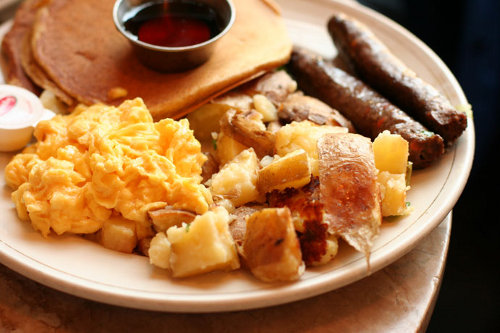 In high school, my nutritionist recommended that I start eating breakfast every day to be in the best shape for softball season. I couldn’t see how eating at six o’clock in the morning could be beneficial. I was completely nauseated first thing in the morning from lack of sleep and a stressful course load and I told the nutritionist so.
In high school, my nutritionist recommended that I start eating breakfast every day to be in the best shape for softball season. I couldn’t see how eating at six o’clock in the morning could be beneficial. I was completely nauseated first thing in the morning from lack of sleep and a stressful course load and I told the nutritionist so.
I’ll never forget what she said in response, “Eat breakfast like a king, lunch like a prince, and dinner like a pauper.” Little did I know that she’d passed on advice so sage that I’d remember and pass it on 15 years later.
If you’re a bodybuilder and you eat a skimpy breakfast, listen up. Whether you’re on season or off, you’ve got to eat a king’s breakfast. It’s what kicks your body out of a fasting state and gets it ready to engage in the day’s activities.
Why Breakfast?
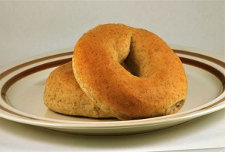 When you wake up in the morning, your body is in a catabolic state. That is, it’s starting to scavenge amino acids from your muscles and fat from your fat stores. Unless you eat at least every six to eight hours, this is inevitable. The trick is getting the nutrition you need back into your body as soon as possible, and breakfast is the best time for that.
When you wake up in the morning, your body is in a catabolic state. That is, it’s starting to scavenge amino acids from your muscles and fat from your fat stores. Unless you eat at least every six to eight hours, this is inevitable. The trick is getting the nutrition you need back into your body as soon as possible, and breakfast is the best time for that.
You may know that the best time to consume carbohydrates is after your workout. What you may not have realized is that breakfast is the other best time to eat carbs. This is because glycogen stores are lowest in the morning. Glycogen is the term for energy stored in the muscles and liver that is readily converted to glucose and is the primary fuel for cells.
When you don’t eat enough good carbs, the muscles don’t store enough glycogen in the muscles, and you won’t have the energy you need to get through a tough workout. Conversely, when you start the morning with good carbs and protein, they work together to push amino acids back into the muscles and increase glycogen stores. This combination gives you the size you’re looking for and the energy to keep up with your workouts and the rest of your life.
Same Old, Same Old
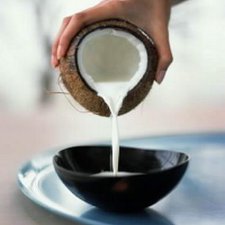 If you lift seriously (or even if you don’t), you know that bodybuilders consume significantly more protein than the average American. On the whole, Joe Couch Potato eats about a diet comprised of about 20% animal protein, and bodybuilders eat anywhere from 30-50% protein, depending on where they are in their training program.
If you lift seriously (or even if you don’t), you know that bodybuilders consume significantly more protein than the average American. On the whole, Joe Couch Potato eats about a diet comprised of about 20% animal protein, and bodybuilders eat anywhere from 30-50% protein, depending on where they are in their training program.
We have discussed about what macros to shoot for in each phase of training. Today we’ll talk a bit about how to combine protein, fat, and healthy carbohydrates to eat like a king and look like a god!
It’s pretty easy to get a huge amount of protein at breakfast. Heck, if you’ve ever seen a Denny’s commercial, you know that you can get eggs, bacon, sausage, and some refined white flour for just a few bucks. If you’re looking to gain good muscle mass and a clean bulk, you’ll want to skip the coronary that “meal” can cause and take a more conservative approach on the fat front.
If there are two breakfasts you’ve heard about as a lifter, they’re egg whites and oatmeal. I’m not going to try to steer you away from either, because they’re both solid sources of good nutrition to start your day. Add a bit of fat in the form of butter or coconut oil, and you’ve got a great breakfast, though perhaps a bit boring.
Another quick and easy option is protein powder, but again, it can old chugging down several protein shakes per day. If you’re in a time crunch, that’s probably your go-to breakfast, and there are thousands of recipes available for that purpose.
Rethinking Breakfast — Fat and Protein
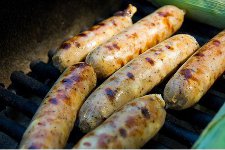 I know people who have made a massive mental shift, taking seriously the idea of eating breakfast like a king. They choose to consume fully half their daily caloric needs at breakfast, hit the gym hard afterward, then go on with their days.
I know people who have made a massive mental shift, taking seriously the idea of eating breakfast like a king. They choose to consume fully half their daily caloric needs at breakfast, hit the gym hard afterward, then go on with their days.
I’ve also tried it myself, but find that when I eat that many calories that early in the day, I just can’t eat enough over the remaining hours to meet my nutritional needs when I’m lifting heavy. What works for me is one-third of my caloric needs at breakfast, and the other two-thirds spread over the remaining ten hours.
However, I’d encourage you to consider some less obvious choices. What about having some leftover steak for breakfast? Chicken sausage is a great choice, especially the garlic or roasted pepper varieties that are easily sliced and added to an omelette. It’s significantly lower in fat than pork sausage, has huge flavor, and usually just needs to be warmed through to be ready to eat.
I like to have one of those links, six egg whites, and some spinach all mixed up and baking while I shower and get ready for the day. It’s ready when I come down, and I can scoot out the door less than ten minutes later. If you don’t mind your eggs a little tough, you can even add some plain egg protein to the mixture to increase the protein content.
A link of my favorite chicken sausage is 110 kcal with 16 grams of protein and 4 grams of fat. Six egg whites equals 100 kcal with 22 grams of protein and almost no fat. I personally like to add one teaspoon of butter with 35 calories and 4 grams of fat, along with as much spinach as the omelette can hold. All in all, the fat and protein in this meal is great, but we need to add some good carbs to round it out.
Healthy Carbs
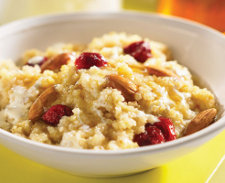 If you want a different kind of hot breakfast cereal, millet is a great option. Millet can be eaten whole (it’s tiny to begin with) or pulsed in a coffee grinder or blender before cooking for a texture more like cream of wheat or grits. I suggest making up a big batch and eating it for a week to see if you like it more than that packet of instant oatmeal.
If you want a different kind of hot breakfast cereal, millet is a great option. Millet can be eaten whole (it’s tiny to begin with) or pulsed in a coffee grinder or blender before cooking for a texture more like cream of wheat or grits. I suggest making up a big batch and eating it for a week to see if you like it more than that packet of instant oatmeal.
Millet cereal
Recipe modified slightly from Foodallergies.about.com
- 3c whole millet
- 8 c water
- 1 1/2 c grated coconut (unsweetened) — optional
- 1/2 tsp. Real Salt
- 1 Tbsp cinnamon
- 1/4 tsp. ground nutmeg (or more to taste)
- 2 tsp. ground cardamom
- In a dry skillet, toast millet over medium-low heat, tossing constantly, until fragrant and slightly golden-brown.
- Grind millet. I prefer to use a coffee grinder, but you can also use a mortar and pestle or a food processor (make sure to use short pulses so as not to end up with a paste). Or put the grains in a plastic or paper bag, and crush them with a rolling pin until finely ground.
- In a medium saucepan, bring water to a boil. Add millet, coconut, salt, cinnamon, nutmeg, and cardamom. Immediately reduce heat to low and cover. Simmer for 15 minutes or until cereal is tender, checking halfway through cooking to make sure water has not all been absorbed. If it has, add another tablespoon or two of water.
If you divide the recipe by seven days, you’ll have 300 kcal, 10 g protein, 15 g fat, 30 g carbs in each day’s cereal, along with five grams of fiber. Add that to the omelette, and you’ve got a breakfast with 545 kcal, 48 g protein, 19 g fat, and about 35 g carbs (depending on how much spinach you add to your eggs).
When you get tired of that breakfast rut, be sure to give these ideas a try. You might just find that your royal appetite has been whetted for even more variety at breakfast!